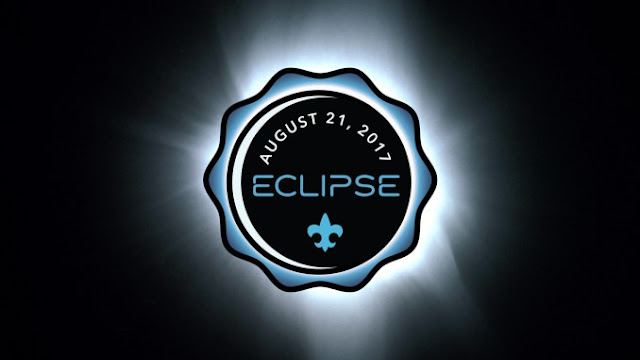A total solar eclipse is a rare event. A total solar eclipse whose path crosses right over the heart of the United States? Even rarer.
On Aug. 21, 2017, the solar system serves up a special treat. Aug. 21 is a Monday, but those Scouts and Venturers who are still on summer break should plan a big celebration. Like all the best celebrations, this one comes with its own patch.
THERE WON’T BE ANOTHER TOTAL SOLAR ECLIPSE OVER THE UNITED STATES UNTIL 2024. AFTER THAT, YOU MUST WAIT UNTIL 2045. IN OTHER WORDS, WHEN AUG. 21 ARRIVES, MAKE SURE YOU’RE READY.
How to earn the BSA 2017 Solar Eclipse patch
- Locate a site suitable for viewing the eclipse. Search Google for “eclipse viewing” and the name of your city or town to find events near you.
- See the exact path and precise timings at this NASA site.
- Describe how to safely view the eclipse. (Completed at the August Pack Meeting)
- Never look directly at the sun. Instead, look directly at these tips from NASA on how to view the eclipse safely.
- Discuss with your group what you saw and felt during the eclipse.
- Post your comments and eclipse photos on social media using the hashtag #BSAEclipse2017.
- Do the following: (Completed at the August Pack Meeting)
- Discuss what a solar eclipse is with your leaders.
- Ask your unit leader to buy the 2017 Solar Eclipse patch.
- It can be ordered through your local council service center.
When Day turns into Night
On Monday, August 21, 2017, a solar eclipse will be visible (weather permitting) across all of North America. The whole continent will experience a partial eclipse lasting 2 to 3 hours. Halfway through the event, anyone within a roughly 70-mile-wide path from Oregon to South Carolina will experience a brief total eclipse, when the moon completely blocks the sun’s bright face for up to 2 minutes 40 seconds, turning day into night and making visible the otherwise hidden solar corona — the sun’s outer atmosphere — one of nature’s most awesome sights. Bright stars and planets will become visible as well.
Only View with Proper Eye Protection
During an eclipse, eye safety is very important. The Sun can be viewed safely with the naked eye only during the few brief seconds or minutes of a total solar eclipse. Partial eclipses, annular eclipses, and the partial phases of total eclipses are never safe to watch without taking special precautions. Even when 99% of the Sun's surface is obscured during the partial phases of a total eclipse, the remaining crescent is intensely bright and cannot be viewed safely without eye protection.
Avoid Eye Damage
Looking directly at the Sun (the bright disk of the Sun itself), even for just a few seconds, can cause permanent damage to the retina of the eye, because of the intense visible and invisible radiation that the sun emits. This damage can result in impairment of vision, up to and including blindness. The retina has no sensitivity to pain, and the effects of retinal damage may not appear for hours, so there is no warning that injury is occurring.
Irreversible Eye Damage within a Fraction of a Second
Under normal conditions, the Sun is so bright that it is difficult to stare at it directly. However, during an eclipse, with so much of the Sun covered, it is easier and more tempting to stare at it. Looking at the Sun during an eclipse is as dangerous as looking at it outside an eclipse, except during the brief period of totality, when the Sun's disk is completely covered (totality occurs only during a total eclipse and only very briefly; it does not occur during a partial or annular eclipse). Viewing the Sun's disk through any kind of optical aid (binoculars, a telescope, or even an optical camera viewfinder) is extremely hazardous and can cause irreversible eye damage within a fraction of a second
